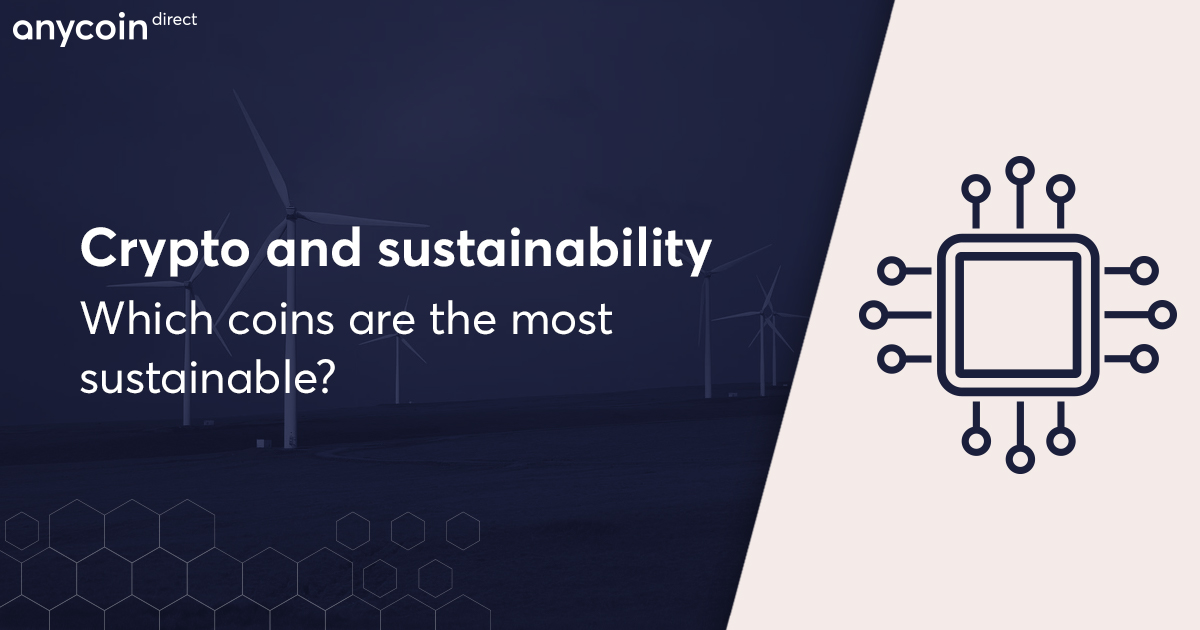Crypto and sustainability. Which coins are the most sustainable?
- 5 minute read

Many coins reached an all-time-high in the last year, cryptocurrency also start having an increasingly big role in our society nowadays. To support this rise of cryptocurrency more technique is necessary, which also means more energy and CO2. What is the influence of cryptocurrency on the environment? Is cryptocurrency sustainable? Which coins are the most sustainable? These questions will be answered in this article.

Is cryptocurrency sustainable?
The first question that arises is, is cryptocurrency sustainable? Regularly people suggest that cryptocurrency is not exactly sustainable. Many people also think this is the case. The University of Cambridge estimated the energy consumption of Bitcoin to be 59,03 terawatt, this is as high as the energy consumption of the whole country of Finland. In the same research was shown that the C02 footprint of BTC is comparable with the country of Ecuador. This big amount of energy is necessary to make sure the datacenters which execute calculations keep running. The energy consumption which is used by the Bitcoin infrastructure is big and will keep growing. This is mainly because the amount of Bitcoin is restricted, therefore increasingly difficult calculations are necessary to mine the coins. This also requires an increasing amount of energy.
Is the sustainability situation around cryptocurrency really this bad? The numbers are a lot more nuanced. If we take the energy consumption of cryptocurrency (around 60 terawatt) and compare it to the energy consumption of the worldwide banking industry (well over 100 terawatt), we can see the number is not that high. Furthermore according to CoinShares 78% of the bitcoin miners use sustainable energy. The increasing popularity of cryptocurrency does also not necessarily cause a higher use of energy. The energy consumption of cryptocurrency is not determined by the amount of transactions in the Blockchain but by the amount of miners that are active.
Yesterday I was pleased to host a meeting between @elonmusk & the leading Bitcoin miners in North America. The miners have agreed to form the Bitcoin Mining Council to promote energy usage transparency & accelerate sustainability initiatives worldwide. https://t.co/EHgLZ9zvDK
— Michael Saylor (@michael_saylor) May 24, 2021
Proof of work versus Proof of stake
If we look at the numbers around energy consumption of cryptocurrency it is remarkable that Bitcoin is often mentioned in combination with excessive use of energy. This is mainly caused because Bitcoin is bases on a ‘Proof of work’ system. In this system miners around the world compete to add new blocks to the blockchain by solving extremely difficult math puzzles. This is done to verify transactions. Because these puzzles are made increasingly difficult, the amount of energy necessary to solve these puzzles is increasing as well. In this proof of work system computers are needed that are running the whole day to solve these hard puzzles. However there is a more sustainable alternative for this relatively inefficient system.
This alternative system is the ‘Proof of stake’ system (also called consensus algorithm). In this system the amount of coins someone owns decides how much mining power a person has. This is called ‘staking’ which is holding the coins. This system does not require difficult puzzles to regulate the mining process. This causes a reduction in the energy consumption needed.
Which coins are more sustainable?
- Cardano ADA: Cardano uses the ‘Proof of stake’ system, people that buy tokens of this coin can participate in the network. This saves a lot of energy as the ADA network only needs 0.006 terawatt to keep running.
- Stellar (XLM): Stellar stared with closing the gap between traditional banks and cryptocurrency and is seen as an alternative for PayPal. The authentication phase with Stellar is shorter which decreases the costs and energy consumption.
- Ripple (XRP): Ripple is a private platform which has a system that exists of ‘validators’ who have to vote about transactions. At least 80% of these validators have to confirm a transaction. This decreases the energy costs of the mining process.
- EOSIO (EOS): Eosio also is a ‘proof of stake’ system in which EOS tokens can be traded.
- Ethereum (ETH): Ethereum is still a big coin that uses a lot of energy but it is relatively energy efficient compared to Bitcoin. Ethereum also claims to strive for a better greener world. They want to show this by switching to a ‘Proof of stake’ system with the new Ethereum 2.0
Read all you need to know on our Ethereum Overview Page.


